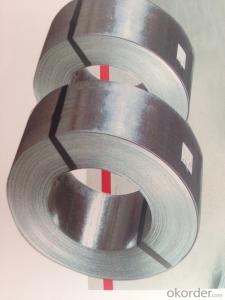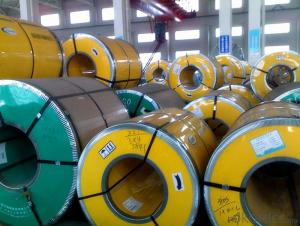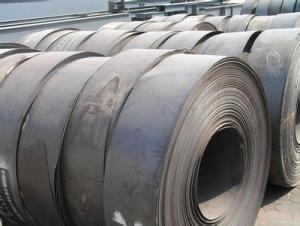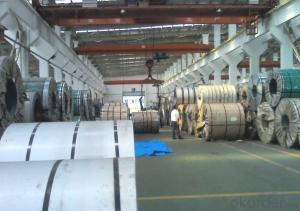Hot dipped galvanized steel strips
- Loading Port:
- China Main Port
- Payment Terms:
- TT OR LC
- Min Order Qty:
- -
- Supply Capability:
- 10000吨 m.t./month
OKorder Service Pledge
Quality Product, Order Online Tracking, Timely Delivery
OKorder Financial Service
Credit Rating, Credit Services, Credit Purchasing
You Might Also Like
Our products are used in steel structure projects and building metallic materials, such as roofing systems, C-shape purlin, U-shape steel channels, welded pipes,and highway guardrails.Our annual production capability has reached 150,000 metric tons.
We have become one of the leading enterprises engaged in the production of hot dipped galvanized steel coils in China, with advanced equipment and technology.
Product Name:hot dipped galvanized steel strips
Features:
1) Available thickness: 1.0mm-3.0mm
2) Available width: less than 700mm
3) Zinc coating mass: 275gsm can be provided as clients' requirements
4) Spangle: regular spangle
5) Surface treatment: chromated or not; oiled or not
- Q:Are steel strips used in the production of kitchen utensils?
- Yes, steel strips are commonly used in the production of kitchen utensils due to their durability and corrosion resistance.
- Q:What are the different rolling processes for steel strips?
- There exist various rolling processes that can be employed for steel strips, each possessing its own distinct characteristics and advantages. Some of the most prevalent rolling processes for steel strips encompass: 1. Hot rolling: By subjecting the steel to elevated temperatures and subsequently passing it through a succession of rollers, its thickness is reduced. Hot rolling is commonly adopted to manufacture large quantities of steel strips with consistent thickness and a smooth surface finish. It finds extensive application in the production of structural components, like beams and plates. 2. Cold rolling: Unlike hot rolling, cold rolling involves passing the steel through rollers at room temperature. This process is employed to produce steel strips with enhanced dimensional accuracy and a superior surface finish. Cold rolling is frequently utilized to manufacture steel strips that necessitate tight tolerances, as seen in the automotive and appliance industries. 3. Skin pass rolling: A type of cold rolling, this process enhances the surface finish and flatness of steel strips. It entails passing the steel through rollers with a minute gap between them, exerting controlled pressure. Skin pass rolling minimizes thickness variations and enhances the surface quality of the steel strips. 4. Tandem rolling: This continuous rolling process entails passing the steel strip through a series of rolling stands in a single operation. Tandem rolling is commonly employed to produce steel strips with diverse thicknesses and widths. It offers high productivity and efficiency, rendering it suitable for large-scale production. 5. Reversing rolling: In this process, the steel strip is passed through a rolling mill in both forward and backward directions to achieve the desired thickness reduction. Reversing rolling is frequently utilized to produce steel strips with significant thickness reduction and a uniform thickness distribution. These examples merely provide a glimpse into the array of rolling processes available for steel strips. The selection of a specific process hinges upon factors such as the desired properties of the steel strips, production requirements, and cost-effectiveness of the process.
- Q:What are the common applications of steel strips in construction?
- Steel strips are commonly used in construction for a variety of applications. They are often used as reinforcement in concrete structures, such as in beams, columns, and slabs, to provide added strength and support. Steel strips are also frequently used for framing and support in walls, roofs, and ceilings. Additionally, they can be used for cladding, providing a durable and aesthetically pleasing exterior finish. Overall, steel strips are versatile and widely utilized in construction for their strength, durability, and ability to withstand various environmental conditions.
- Q:How are steel strips processed for notching?
- Steel strips are processed for notching by using specialized machinery that cuts V-shaped notches into the strips. This process involves feeding the steel strips through the machine, where a cutting tool applies pressure to create precise notches according to the desired specifications.
- Q:How are steel strips used in the production of household tools?
- Due to their durability and strength, steel strips find widespread use in the manufacturing of household tools. These strips serve as raw materials for various tools such as screwdrivers, wrenches, pliers, and hammers. Typically, steel strips are cut into specific lengths and widths before undergoing further processing to shape them into the desired tools. Manufacturers can bend, stamp, or forge these strips to create the necessary components for the tools. For instance, the strips may be bent to form the handles of screwdrivers or pliers, or they may be stamped into the jaws of a wrench. The use of steel strips in tool production offers several advantages. Firstly, steel is a robust material capable of withstanding significant force and pressure, making it ideal for heavily used tools. Secondly, steel exhibits high resistance to corrosion, ensuring that the tools remain in excellent condition even in harsh environments. Moreover, steel strips can be easily molded and shaped, allowing manufacturers to create tools with precise dimensions and intricate designs. This versatility in shaping steel strips enables the production of tools with ergonomic handles, textured surfaces for enhanced grip, and various other features that improve user comfort and efficiency. In conclusion, steel strips play a vital role in the production of household tools, providing durability, strength, and corrosion resistance. Their versatility allows manufacturers to create tools with precise dimensions and designs, resulting in high-quality and dependable products for everyday use.
- Q:How are steel strips processed for roll forming?
- In order to achieve the desired shape and dimensions, steel strips undergo a series of steps for roll forming. The process begins by uncoiling a large coil of steel strip, which is then fed into a roll forming machine. The steel strip is gradually shaped into the desired profile as it passes through a series of rollers. These rollers are meticulously designed to create specific bends, curves, and angles in the strip. The number and arrangement of the rollers can vary depending on the complexity of the desired shape. To ensure accurate and consistent shaping, the steel strip is carefully guided and supported as it goes through the rollers. Guide rolls, side rolls, and idler rolls are employed to maintain the strip's position and prevent any wrinkling or twisting during the process. To further enhance the shaping process, some roll forming machines may incorporate additional techniques such as pre-notching or pre-punching. These techniques involve making small cuts or holes in the strip prior to entering the rollers, facilitating easier bending and forming. Once the steel strip has been fully shaped, it is then cut to the desired length. This can be done either during the roll forming process itself or as a separate step afterwards. Various cutting methods, including shearing, sawing, or punching, can be utilized depending on the specific requirements of the final product. Following the cutting stage, the formed steel strips may undergo additional processes such as hole punching, embossing, or adding surface finishes. These processes serve to enhance the functionality or aesthetic appeal of the final product. Overall, the roll forming process for steel strips involves precise shaping, meticulous support, and accurate cutting to produce a wide range of profiles and shapes. This versatile manufacturing technique is extensively utilized in industries such as construction, automotive, and appliances to manufacture components and structures that possess high strength and durability.
- Q:Can steel strips be used in the production of kitchen utensils?
- Yes, steel strips can be used in the production of kitchen utensils. Steel is a common material choice for utensils due to its strength, durability, and resistance to corrosion. Steel strips can be shaped and formed into various kitchen utensils like knives, spoons, forks, and spatulas, providing a reliable and long-lasting option for culinary purposes.
- Q:How are steel strips processed for heat dissipation?
- Steel strips are processed for heat dissipation through various methods such as heat treatment, surface coating, and the incorporation of cooling elements. These processes help enhance the steel's ability to absorb and dissipate heat, ensuring efficient heat management in applications such as electronic devices, automotive components, and heat exchangers.
- Q:Are steel strips resistant to staining or discoloration?
- Yes, steel strips are generally resistant to staining and discoloration due to their corrosion-resistant properties, making them suitable for various applications where aesthetics and durability are important.
- Q:How are steel strips processed for fire resistance?
- There are several methods available for processing steel strips to enhance their fire resistance. One commonly used approach involves applying a fire-resistant coating onto the surface of the strip. This coating serves as a protective barrier, capable of withstanding high temperatures and preventing the steel from reaching its critical temperature, which is the temperature at which it loses its structural integrity. Various techniques, including spray coating, dip coating, and electrostatic deposition, can be employed to apply the fire-resistant coating. Another method to enhance the fire resistance of steel strips involves the use of intumescent coatings. These coatings are designed to expand when exposed to high temperatures, creating a thick and insulating layer that acts as a shield against heat transfer. Intumescent coatings can be applied in the form of paint or a thin film on the surface of the steel strip. Fire-resistant insulation materials offer an additional means of enhancing the fire resistance of steel strips. These materials are applied to the strip to provide extra insulation and protection against heat. Examples of insulation materials include mineral wool, ceramic fiber, and vermiculite boards, all of which possess excellent fire resistance properties. It is crucial to consider that the specific process for enhancing the fire resistance of steel strips may vary depending on the intended application and the desired level of fire protection. Therefore, consulting with experts in the field of fire protection is essential to determine the most suitable method of processing steel strips for fire resistance in a particular scenario.
1. Manufacturer Overview |
|
|---|---|
| Location | |
| Year Established | |
| Annual Output Value | |
| Main Markets | |
| Company Certifications | |
2. Manufacturer Certificates |
|
|---|---|
| a) Certification Name | |
| Range | |
| Reference | |
| Validity Period | |
3. Manufacturer Capability |
|
|---|---|
| a)Trade Capacity | |
| Nearest Port | |
| Export Percentage | |
| No.of Employees in Trade Department | |
| Language Spoken: | |
| b)Factory Information | |
| Factory Size: | |
| No. of Production Lines | |
| Contract Manufacturing | |
| Product Price Range | |
Send your message to us
Hot dipped galvanized steel strips
- Loading Port:
- China Main Port
- Payment Terms:
- TT OR LC
- Min Order Qty:
- -
- Supply Capability:
- 10000吨 m.t./month
OKorder Service Pledge
Quality Product, Order Online Tracking, Timely Delivery
OKorder Financial Service
Credit Rating, Credit Services, Credit Purchasing
Similar products
New products
Hot products
Related keywords



























